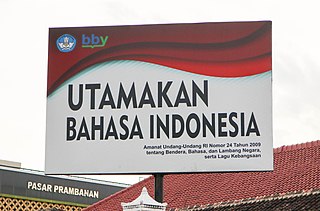Related Research Articles
The Karkar language, also known as Yuri, is the sole Eastern Pauwasi language of Papua New Guinea. There are about a thousand speakers along the Indonesian border spoken in Green River Rural LLG, Sandaun Province.
Usku, or Afra, is a nearly extinct and poorly documented Papuan language spoken by 20 or more people, mostly adults, in Usku village, Senggi District, Keerom Regency, Papua, Indonesia.

Indonesia is home to over 700 living languages, creoles, and dialects spoken across its extensive archipelago. This significant linguistic variety constitutes approximately 10% of the world’s total languages, positioning Indonesia as the second most linguistically diverse nation globally, following Papua New Guinea. The majority of these languages belong to the Austronesian language family, prevalent in the western and central regions of Indonesia, including languages such as Acehnese, Sundanese, and Buginese. In contrast, the eastern regions, particularly Papua and the Maluku Islands, are home to over 270 Papuan languages, which are distinct from the Austronesian family and represent a unique linguistic heritage. The language most widely spoken as a native language is Javanese, primarily by the Javanese people in the central and eastern parts of Java Island, as well as across many other islands due to migration.

Papua New Guinea, a sovereign state in Oceania, is the most linguistically diverse country in the world. According to Ethnologue, there are 840 living languages spoken in the country. In 2006, Papua New Guinea Prime Minister Sir Michael Somare stated that "Papua New Guinea has 832 living languages ."
The Pauwasi languages are a likely family of Papuan languages, mostly in Indonesia. The subfamilies are at best only distantly related. The best described Pauwasi language is Karkar, across the border in Papua New Guinea. They are spoken around the headwaters of the Pauwasi River in the Indonesian-PNG border region.

Keerom Regency is one of the regencies (kabupaten) in the Papua Province of Indonesia. It was formed from the eastern districts then within Jayapura Regency with effect from 12 November 2002. It covers an area of 9,365 km2, and had a population of 48,536 at the 2010 Census and 61,623 at the 2020 Census; the official estimate as at mid 2022 was 63,499. The regency's administrative centre is at the town of Waris.

Pegunungan Bintang Regency or Bintang Mountains Regency is a regency in the Indonesian province of Highland Papua. It was created on 11 December 2002 from the north-eastern districts of Jayawijaya Regency. It covers an area of 15,683 km2, and had a population of 65,434 at the 2010 Census and 77,872 at the 2020 Census; the official estimate as at mid 2022 was 78,466 - comprising 42,362 males and 36,104 females. The administrative centre is the town of Oksibil.
Molof is a poorly documented Papuan language spoken by about 200 people in Molof village, Senggi District, Keerom Regency.
Tofanma or Tofamna is a poorly documented Papuan language of Indonesia. Wurm (1975) placed it as an independent branch of Trans–New Guinea, but Ross (2005) could not find enough evidence to classify it. It appears to be related to Namla, a neighboring language.
Demta, also known as Sowari and Muris, is a Papuan language on the north coast of Papua, Indonesia. It is spoken in Ambora, Muris Besar, Muris Kecil, and Yougafsa villages, all located in Demta District.
Murkim is a Papuan language of Western New Guinea, near its relatives Lepki and Kembra. Though spoken by fewer than 300 people, it is being learned by children. It is spoken in Murkim District, Pegunungan Bintang Regency, Papua Province, Indonesia.

Kaure is a Papuan language of West Papua. It is spoken in the villages of Lereh, Harna, Wes, Masta, and Aurina.
Yetfa and Biksi are dialects of a language spoken in Jetfa District, Pegunungan Bintang Regency, Highland Papua, Indonesia, and across the border in Papua New Guinea. It is a trade language spoken in Western New Guinea up to the PNG border.
Sowanda is a Papuan language of Sandaun Province, Papua New Guinea, with a couple hundred speakers in Indonesian Papua.
Kimki (Aipki) or Sukubatom (Sukubatong) is a South Pauwasi language of Batom District, Pegunungan Bintang Regency, Papua, Indonesia. Foley classifies Kimki as a language isolate, although he notes some similarities with Murkim. Usher demonstrates a connection to the other South Pauwasi languages.
Towei (Towe) is a Western Pauwasi language of West New Guinea. It is spoken in Towe Hitam village, Towe District, Pegunungan Bintang Regency.
Tebi, also known by the village name Dubu, is a Western Pauwasi language of West New Guinea. It is spoken in Affi, Dubu, and Jembatan Web villages of Keerom Regency. It is mostly used by older adults.
Yafi, also known as Zorop, is an Eastern Pauwasi language of West New Guinea. It is spoken in Warlef village, Senggi District, Keerom Regency.
Senggi District is a district in Keerom Regency, Papua, Indonesia.
The East Pauwasi languages are a family of Papuan languages spoken in north-central New Guinea, on both sides of the Indonesia-Papua New Guinea border. They may either form part of a larger Pauwasi language family along with the Western Pauwasi languages, or they could form an independent language family.
References
- ↑ Emem at Ethnologue (18th ed., 2015) (subscription required)
- ↑ Lee, Myung-Young. 2006. Laporan survei pada bahasa Emem di Papua, Indonesia . SIL International.
- ↑ Lebold, Randy and Myung-Young Lee. 2016. Survey Report on the Emem Language of Papua, Indonesia . SIL Electronic Survey Reports 2016-008.